The most important tool you can have that will increase your chance of survival is knowledge, nowhere is this more apparent than in a desert survival situation.
If you know how to find water, shelter, and how to survive in extremely hot and hostile conditions, then your chances of survival will increase greatly.
As the title suggests this post will only be concentrating on one aspect of desert survival; how to find water in the desert.
Before we cover the specifics of how to do so you first need to understand how heat and dehydration effects the human body and what are the best ways to conserve whatever water you have. Being able to conserve water is obviously the most effective way of fending off dehydration.
How Much Water does the Body Need in a Desert Climate
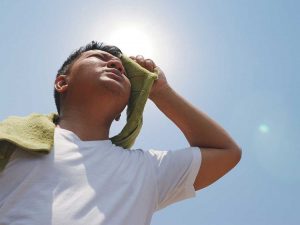
Without water we would very quickly dehydrate, making it practically impossible for our bodies to function properly, either mentally or physically.
Once you are dehydrated, unless it is very quickly reversed, it will result in death.
This is why it is so important to have an understanding of water consumption in relation to air temperature and activity level. Having this knowledge is an extremely important factor in learning how to survive in desert zones.
An average person, with a normal body temperature of 36.9C (98.6F), located in a comfortable mild climate without undertaking any physical exertion would require approximately half a gallon of water a day to maintain a level of hydration deemed to be healthy.
An increase in the level of activity or of the air temperature will result in perspiration, the body’s defence mechanism against overheating. If activity and air temperature continue to increase so will the body’s level of sweating and if you haven’t guessed already, sweating is the main reason for dehydration.
This is why the standard requirement of drinking a half gallon of water a day can very quickly jump up to 4 or 5 gallons in extremely hot conditions especially under high activity levels.
Prolonged activity in high temperatures can lead to heat exhaustion.
If after a long spell of heavy sweating in intense heat a person stops sweating altogether it is a sign of the onset of heatstroke, sometimes called sunstroke, which is extremely dangerous to an individual’s health and will require medical attention immediately.
Before we get into the ‘nitty gritty’ of how to look for water in the desert it would be inexcusable not to mention the preventative measures that should be taken in order to avoid putting yourself in a situation that is very often avoidable, whilst in the middle of a hot and arid region!
- Before venturing out into remote areas make sure you have told someone where you are planning on going to, the route you will be taking, and your return date. DO NOT DEVIATE FROM THIS PLAN. Read the book ‘Between a Rock and a Hard Place‘ or check out the movie based on the book called ‘127 hours‘ and you’ll understand why this is so important.
- A trip into a desert should only be undertaken with the proper supplies and only when everything has been thoroughly planned out. NEVER take a trip into any hostile environment on a last minute whim.
- When readying your water supply make sure the containers you will be using are up to the task, you do not want to lose all your water because your containers break or leak.
So even after taking all these preventative and cautionary measures you still find yourself lost in the desert with only a limited supply of water what next?
Rationing water, will it help?
Okay, even if you have drinking water with you, the chances are you will not be carrying enough should you get lost.
Remember, in the heat of the desert sun you will need to drink a lot more water than usual so even if it seems like you are carrying plenty it will probably end up being nowhere near enough.
In a situation where somebody is unsure about how long it will be before they find water, or are found, most people would consider rationing to be a sensible step to take. Sorry, we are going to burst that bubble now; it isn’t!
Rationing water will only bring on the effects of dehydration sooner, meaning the body will function less effectively at a time when you desperately need it to perform at its optimum.
Rather than rationing your water you should be looking at ways to conserve what you have.
Best Ways to Conserve Your Water in the Desert

We’ve already mentioned that rationing is a no go, so if you can’t cut back on water then you have to cut back on how much you need!
In other words, you need to sweat less! The less you sweat the less water you need to drink.
Here are a number of ways to reduce the amount of water you need:
- Let’s start with the most obvious one. Get out of the sun and find some shade. – The amount of water you need, will reduce significantly if you sit quietly in shade, fully clothed, mouth closed, only breathing through your nose. Always try to keep something between you and the ground, which is generally hot even in the shade.
- Keep movement and activity to a bare minimum – If you have to travel then do so at night if possible or slowly if you have to in the day.
- Remain fully clothed – Even though you will want to remove clothing don’t and keep your head and neck covered at all times. By remaining fully clothed the rate at which your sweat evaporates will slow down which is a good thing as it prolongs the cooling effect.
- Eat only when absolutely necessary – Digestion requires water so any food you eat will use water required for cooling/sweating.
- No smoking or drinking alcohol – both will make you dehydrate more quickly. (Alternatively, if all is lost, to hell with it, have a party!)
Okay so now we know how to minimize our water requirements let’s learn how to find some desert water!
There isn’t any Water in the Desert, is there?

It may not always be obvious, or easy to find, but all deserts will have a certain amount of water, some actually have more than you think!
The truth is, wherever there is life you will find water, and the desert, inhospitable as it is, is a throng of wildlife and fauna.
You may ask then that if this is the case why do so many people die of dehydration in the desert? The simple answer is that they don’t know where to look for it. We’re going to resolve that issue.
The following vital information will instill in you the knowledge you need in order to find water in any desert survival situation you may possibly find yourself in.
Using the Local Wildlife to Find Water
Finding water in the desert is challenging, but it’s not impossible. People often die in the desert because they couldn’t find water, not because there isn’t any. To put it simply, most people don’t know where to start looking for it.
One proven method of finding water is to watch the local wildlife.
Most animals will have places where they go to drink on a daily basis so following them to these locales makes perfect survival sense. The trouble is that animals living in the desert generally tend to be nocturnal, none of them are stupid enough to venture out into the heat of the desert sun, and nor should you, truth be said!
However, tracking animals at night is hard enough in temperate climates, in the cold desert night and when worn down through dehydration it can become practically impossible. Basically, tracking larger desert wildlife is going to be a non-starter in most cases, but there are many other creatures that will point you in the right direction.
Flying insects
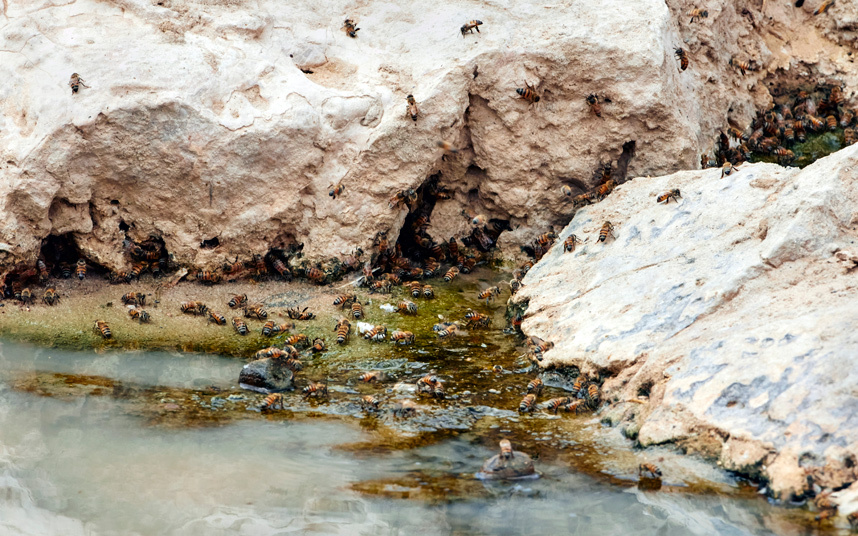
You would be especially lucky should those insects be bees.
Beehives are pretty much always found within 3–5 miles of a water source. If you see bees, you just have to watch the direction they are flying. They’ll either lead you to their hive or to their water source.
If you follow the flight path of the bees and you discover a hive, find a high vantage point close to the hive so that you can see the surrounding landscape. You will be looking for small areas of dark green vegetation as there is a good chance that would probably be where the bees are flying to for their water.
Non-flying Insects
Most ground dwelling desert insects are pretty hard to spot as they are experts at staying hidden. Understandable when you consider that nourishment is not easy to find in the desert, and they could be on the menu if they stood out too much!
if you do find a few desert insects close together they will generally be close to their nest, which as it happens, will also be relatively close to a water source.
Just remember that a single insect alone does not necessarily mean water is nearby but, as with flying insects, if you see a good number of them in a small area, the likelihood is that there will be.
Ants for example are a great indicator. If you find and follow a line of ants, you will often find that one end of the line will lead to a water source.
Reptiles – Snakes and Lizards
While reptiles do not always lead you to water directly, they will nevertheless help you find what you need.
By following reptile tracks you will be able to locate their burrows or where they sun themselves both will be close to their food source which just happens to be insects. Where better to find a large number of insects than in a nesting location and as mentioned previously, insects will nest near to water.
Birds and Mammals
As you have probably already concluded, almost every living creature will suggest a source of water is nearby, some require greater quantities of water than others. Birds and mammals fall into that group, particularly mammals.
In arid, desert like conditions, both birds and mammals will generally make their way to water at dawn and dusk, the cooler parts of the day.
In cases where you do not physically see animals on their way to watering holes etc, you will still be able to find their water sources by learning how to follow tracks and trails that will often lead to water.
Obviously birds do not use trails, well not on the ground anyhow, but you can still get a good idea where they are going to or coming from by the way they fly. When birds are flying towards their water source they will generally tend to fly low and directly, not deviating at all.
Once having watered their flight back will be staggered as they will rest often and will fly from tree to tree. This type of behavior is far more prevalent in grain eating birds such as pigeons, birds of prey and water birds (which you probably won’t find in the desert funnily enough!) are less reliable when using this type of observational tracking.
Using Landscape Features to Identify Possible Water Locations
Dense Areas of Green Plant Life
Any plant you find in the desert will require water to survive, even if it is the most minuscule amount. A single plant will mean that there is water in the vicinity. It would seem obvious therefore that an increase in the number of plants you can see, and the more dense and green they become the greater the indication that they are tapping into a greater quantity of water.
In short, head towards areas of dense vegetation to find water.
If you can’t see any pockets of vegetation where you are, you will need to find some high ground to increase your viewing range.
Trees
Trees take a long time to grow and require water on a regular basis to do so. If you can spot a tree in a desert you can be quite certain that there will be water nearby.
All trees require water, but certain types of tree require more than others, Willows and Cottonwoods are particularly thirsty trees so if you come across either of them then you have hit the jackpot, although any broad leafed tree you can find is a great indicator of nearby water.
You will find a spring or a watering hole extremely close to a tree in most cases although that isn’t always the case. Tree roots can tap down into the ground quite a lot to find water so you may not always find surface water. If this is the case you can dig down through the tree roots. Even if it the dirt you are digging down into may seem pretty dry, in most cases the hole will slowly start to fill with water.
As mentioned earlier, any physical exercise will increase dehydration so if you need to dig then do so at night or in the cooler parts of the day. You will also find that the tree will offer much needed shade too, so take advantage of this also.
Stumps and Fallen Trees
If you come across dead trees or stumps you may be in luck because even though the tree itself may be dead the wood will be porous or contain hollows that will sometimes hold water.
A good indication that an old dead tree contains some water is if you see insect life busily entering and exiting the tree. Whatever you do, do not stick your arm into any holes or crevices you find in the tree whilst trying to check it for water. The chances are by doing so you could end up making your situation a hundred times worse by disturbing a snake or a poisonous spider.
Instead, attach something absorbent like a tee-shirt onto a stick and insert that into the hole. You might still disturb a snake still but at least you’ll be in a better position to retreat unscathed.
If you pull the cloth out of the tree and it is wet then wring it out into a container and continue the process until there is no more.
Dry Riverbeds and Waterholes
If you have been lucky enough to find a dry riverbed, waterhole, or the like you shouldn’t be completely disheartened. There is a pretty good chance that although the surface water is gone there could well be a hidden store of water to be found by digging down a bit.
If you dig down a few inches and you find even the slightest amount of moisture the chances are there will be a lot more deeper down so carry on digging. Once you have dug down deep enough that the soil is noticeably moist you can stop and cover the hole as best you can in order to stop any of the local wildlife from drinking or contaminating your waterhole and then wait.
After a few hours you should find that the hole has filled with water.
If it is a dry riverbed you’ve found then look to dig on the outer bend of a turn as the chances of finding a greater accumulation of subterranean water is higher than on other parts of the dried riverbed.
Rock Formations
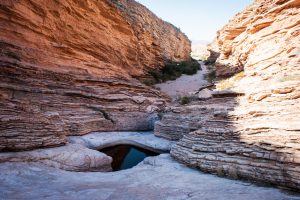
North facing canyons themselves are great locations for finding water as any collected in them during storms normally takes a long time to evaporate which is great but could also mean that the water becomes stagnant as it will be sitting for a long time. This means it will need to made safe before being used for drinking water. Having some water purification tablets or a survival straw in your emergency gear will resolve this issue.
As mentioned earlier, when looking in cooler, shadier areas for water, you should always be wary of local wildlife that will be hiding from the hot sun, namely snakes, spiders, and scorpions!
Hills
Water will always accumulate at the lowest point of any terrain, so if there are hills near to your location there is a chance that you may find water at the base of them.
Alternative Sources of Water
 Moisture from Leaves
Moisture from Leaves
If you have a plastic bag (unlikely, but possible) and there are bushes or trees close by, then collecting the vapor that leaves omit daily could provide you with a small amount of water. This is a process called transpiration.
If you completely enclose a throng of leaves with the plastic bag then tie the open end of the bag tight around the stem or branch, any moisture that the leaves lose will be collected.
If you place a pebble in the bag it will create a low point in the bag where the collected water will pool.
As already mentioned, this method won’t provide a lot of water but it will provide a mouthful or two.
Cactus
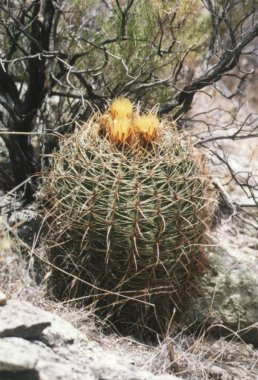
Most cacti grow in extremely dry parts of the world surrounded by wildlife that will always be looking for water to drink. Would it not be safe to presume therefore that these cacti have evolved to protect themselves by making any fluid that they contain undrinkable?

However, the reason we have included cactus water here is that there are two specific types of cactus that can provide hydration with a relative degree of safety, the prickly pear and the fishhook barrel (Ferocactus wislizeni). Neither of these cacti are particularly pleasant when eaten raw but they will not have the seriously detrimental effects experienced by eating/drinking the juice from a alkaloid heavy cactus.
Cactus fruits such as those of the prickly pear are the best better for hydration purposes and are a cooked staple in some parts of the world, mainly the countries of Central America.
Collecting Dew in the Desert

Before we outline the best method for collecting desert dew there are a few things that you need to take into consideration.
- Do not collect dew from the surface of poisonous plants or from plants in very close proximity to poisonous plants.
- In the unlikely event that the area of desert you find yourself in has been treated or sprayed with chemicals you should again avoid collecting dew from any vegetation.
- Do not collect dew from places where there has been noticeable animal defecation
- Do not collect dew from vegetation that is found on by the side of roads.
A Simple Method for Collecting Dew
- Step 1: Find an area with a good amount of dew
- Step 2: Wipe up the dew with an absorbent material
- Step 3: Wring out the dew into a container
There are only three steps to dew collection:
1: Locate a dew heavy area
The highest level of dew formation can always be found first thing in the morning just prior to the sun’s rays hitting and drying it up. The best types of plants for excessive dew formation are grasses although plants such as burdock or grape that have bigger leaves work pretty well too.
2: Soak up the dew with an absorbent piece of material
The simplest way to harvest dew is to soak it up using something that is extremely absorbent, a tee-shirt perhaps.
3: Squeeze out the absorbed dew
Finally, simply wring the tee-shirt, or whatever you used, and collect the water in a container or directly into your mouth.
…the last word!
Taking enough water with you is by far the easiest way to ensure you don’t end up in a survival situation.
Always carry more than you think you need — a minimum of 2 liters per day per person means you need to carry at least one gallon a day per person in the desert. If it’s up to you to find water on the road, make sure you know where the water is before setting out and also how reliable the water source is.
Knowing all the possible emergency water sources when in the desert and how to find them is invaluable knowledge to have, but putting that knowledge into practice in preparation for when it is needed is more than important, it’s vital.
Whenever you are visiting the desert use the guide above to start honing your water finding skills, do not wait until you are in a life and death situation before putting the theory into practice.


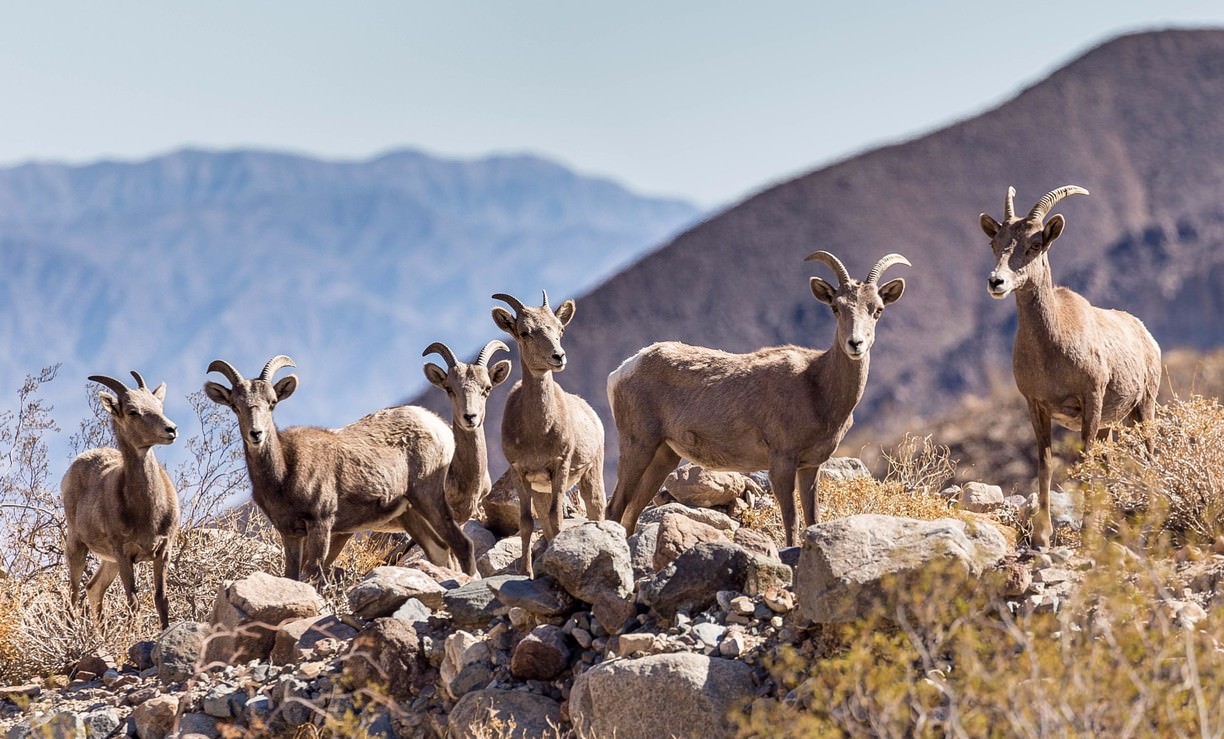
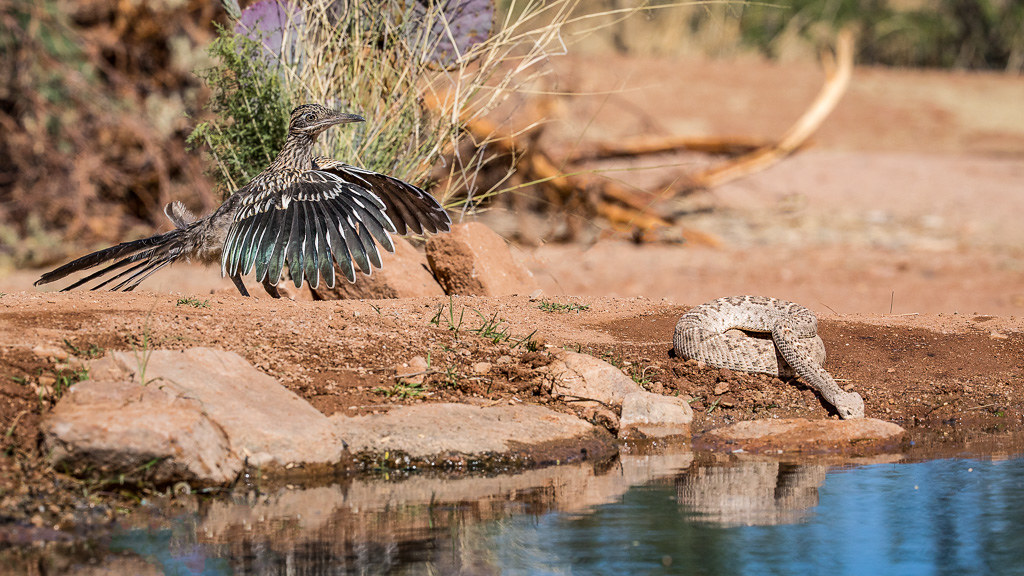
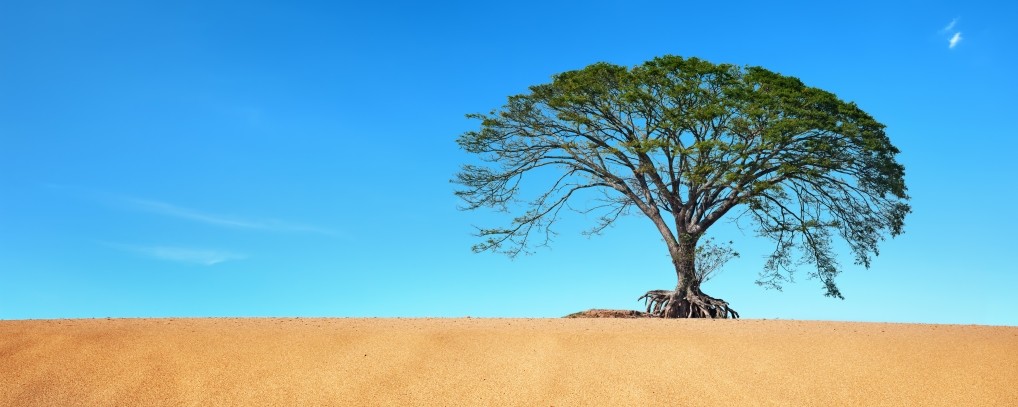
 Moisture from Leaves
Moisture from Leaves